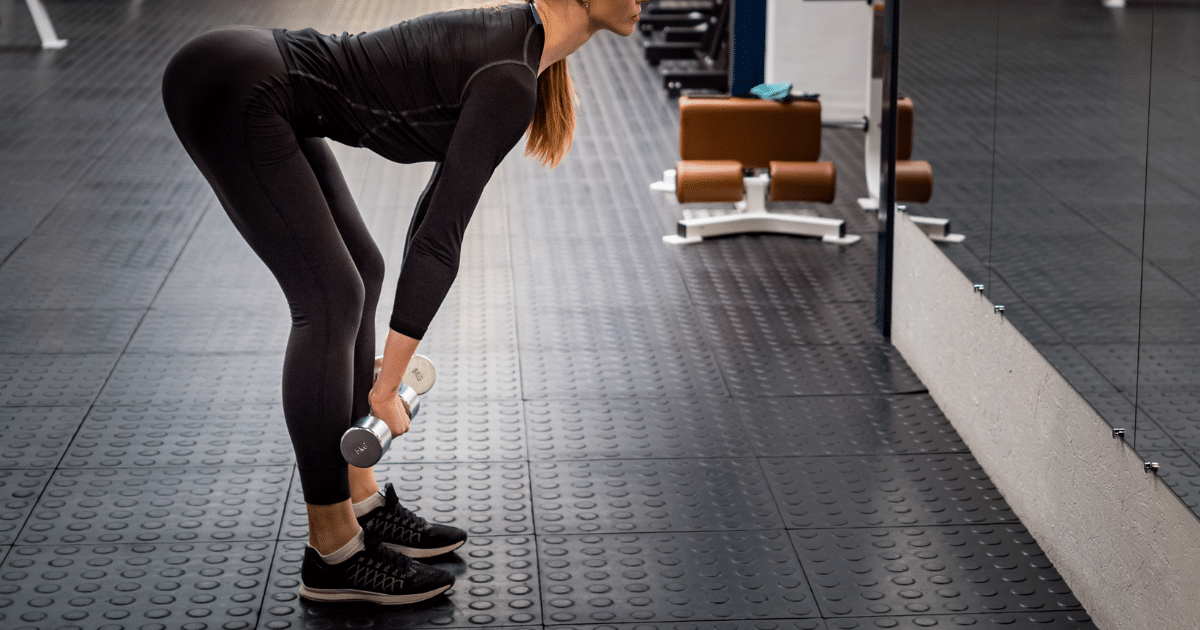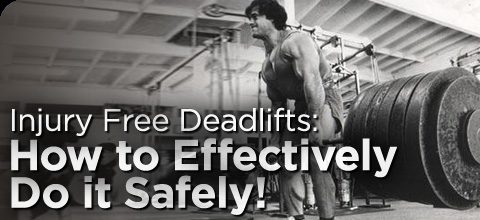Injury Free Deadlift: How to Effectively Do it Safely
The deadlift is definitely an exercise where if you have poor form, you are going to be in a world of hurt. Poor form on an exercise such as this and you could really mess up your back. This article is to teach you the proper technique and form to execute the deadlift.
The deadlift is a great exercise to help develop the hamstrings and the lower back. The exercise is done by pulling the weight off of the floor and in then standing with your legs straight and your shoulders back. To keep pressure off of your spine and lower back muscles it is important to keep your back straight.
You really want to concentrate on sitting back as if sitting in a chair when you are deadlifting. You want to get a good grip on the bar and can also use some straps to ensure your grip on the bar. Once you have a reverse grip on the bar (one hand over, one hand under) you want to drive the weight from your heels through your legs.
Related Article: The Worst Fitness Injuries and What To Do About Them
In the down position, you want to have your thighs parallel to the floor. You should have your knees directly over your feet. Make sure your knees aren’t past your toes or behind your heels. You want to keep your butt low to the ground in the downward position. If you have too much weight on the bar for you to handle a tale tell sign is that your butt will but raises instead of down and your back will be rounded. Make sure this doesn’t happen or injury can occur.
The next portion of the movement is very important to execute the movement with power. You want to use your glutes and quads and explode the weight off of the floor. You want to think of the movement more as a push than a pull movement. Your lower body muscles should be doing the work, not your arms and traps.
Disclaimer: This article is for informational purposes only and is not meant to treat or diagnose any condition. It is recommended that you speak with your doctor before starting any exercise program, changing your daily nutrition, or adding any supplements to your regimen.
The Stiff-Leg Deadlift
The stiff-leg deadlift is a little trickier when compared to its cousin the deadlift. You want to begin by having a shoulder width stance over the bar. You want to have your feet straight ahead or even angled out to the sides slightly. You can experiment a little bit to see what works and feels best for you. By finding a foot position that keeps you stable you will be able to use heavier weights. Make sure your feet stay flat on the floor at all times.
Related Article: Benefits of the Leg Press for Building Massive Legs
At this point, you want to have the bar close by your shins (about 2 inches from the bar is good). Just like with the standard deadlift, it is best to use a reverse grip for this style of the deadlift as well. Grip the bar with your arms just slightly out wider than your thighs. Again, if your grip strength is weak, you can use straps to ensure a better contact and grip with the bar.

You want to make sure that your head follows your body. It is ok to look up slightly but for the most part, you want to make sure your entire spine is in a neutral position. The weight should be on your heels. This will make sure you hit your hamstrings and glutes. The name is obviously the stiff-leg deadlift; however, it is best to keep your knees just slightly bent throughout the movement.
Related Article: 7 Hip Exercises You Should Do to Improve Mobility
Now for the lift portion of the movement. As you bring the weight off of the floor, you should be bringing the weight up using your hamstrings. It should feel as if you are driving your hips forward. Make sure that your shoulders and hips are ascending together, if they aren’t then you know you are using more of your lower back rather than your hamstrings. Bring the weight all the way up until you are standing straight up. Now that you made it past the hardest part, reverse the order you just went through and bring the bar back down to mid to lower shin and then ascend the weight again. Make sure you are using a controlled motion throughout the movement to not only prevent injuries, but to also hit the muscles you are trying to target.
Common Form Issues with This Exercise

The stiff-leg deadlift is a popular exercise for targeting the hamstrings, lower back, and glutes. However, like any exercise, it’s important to perform it with proper form to maximize effectiveness and minimize the risk of injury. Here are some common form issues associated with the stiff-leg deadlift:
- Rounding the Back: One of the most common mistakes is rounding the back during the movement. This can place excessive stress on the spine and increase the risk of injury. Instead, maintain a flat or slightly arched back throughout the exercise.
- Bending the Knees Too Much: While some knee flexion is acceptable in the stiff-leg deadlift, excessive bending of the knees turns it into more of a conventional deadlift. To target the hamstrings effectively, keep a slight bend in the knees but avoid excessive flexion.
- Not Keeping the Bar Close to the Body: Allowing the barbell to drift away from the body during the movement can lead to inefficient mechanics and strain on the lower back. Keep the barbell as close to the body as possible throughout the entire range of motion.
- Locking Out the Knees: While it’s important to fully extend the hips at the top of the movement, avoid locking out the knees. Locking out the knees can place undue stress on the joint and reduce tension in the hamstrings. Instead, maintain a slight bend in the knees at the top of the movement.
- Lack of Hip Hinge: The stiff-leg deadlift is a hip hinge movement, meaning the majority of the movement should come from the hips, not the lower back. Initiate the movement by pushing your hips back as if you’re trying to touch something behind you with your glutes.
- Overarching the Lower Back: While it’s essential to maintain a neutral spine, some individuals tend to overarch their lower back at the bottom of the movement. This can lead to hyperextension and potential injury. Focus on bracing your core and keeping your spine in a neutral position throughout the exercise.
- Not Controlling the Descent: Lowering the weight too quickly or without control can increase the risk of injury and diminish the effectiveness of the exercise. Lower the weight under control, maintaining tension in the hamstrings and keeping the back flat.
- Using Too Much Weight: Trying to lift too much weight can compromise form and increase the risk of injury. Start with a lighter weight and focus on mastering the technique before gradually increasing the load.
To avoid these common form issues, it’s crucial to practice proper technique, start with lighter weights, and gradually progress as you become more comfortable with the movement. Additionally, seeking guidance from a qualified fitness professional can help ensure you’re performing the stiff-leg deadlift correctly and safely.


*Disclosure: This article may contain affiliate links or ads, which means we earn a small commission at no extra cost to you if you make a purchase through these links. These commissions help support the operation and maintenance of our website, allowing us to continue producing free valuable content. Your support is genuinely appreciated, whether you choose to use our links or not. Thank you for being a part of our community and enjoying our content.
PLEASE CONSIDER SHARING THIS ON YOUR SOCIAL MEDIA TO HELP OTHERS LEARN MORE ABOUT THIS TOPIC. SIMPLY CLICK BELOW!

